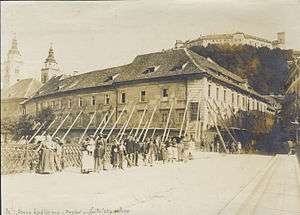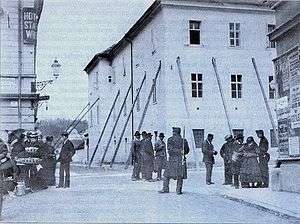1895 Ljubljana earthquake
The 1895 Ljubljana earthquake (Slovene: ljubljanski potres)[1] or the Easter earthquake (Slovene: velikonočni potres)[2] struck Ljubljana (the capital and largest city of Carniola, a Crown land of Austria-Hungary and the capital of Slovenia) on Easter Sunday, 14 April.[1] It was the most,[3] and the last, destructive earthquake in the area.[4]



Earthquake
With a Richter magnitude of 6.1 and a maximum Mercalli Intensity of VIII–IX, the earthquake struck at 20:17 UTC (22:17 local time).[2] The earthquake's epicentre was located in Janče, about 16 kilometres (10 mi) to the east of the Ljubljana downtown.[5] The focus was 16 kilometres (10 mi) deep. The shock was felt in a circle with a radius of 350 kilometres (220 mi) and an area of 385,000 square kilometres (149,000 sq mi), reaching as far away as Assisi, Florence, Vienna, and Split.[4] More than 100 aftershocks followed in the next ten days.[2]
Damage
The largest damage was caused in a circle with a radius of 18 km (11 mi), from Ig to Vodice.[2] At the time, Ljubljana's population was some 31,000, with around 1,400 buildings.[2] About ten percent of buildings were damaged or destroyed, although few people died in the destruction.[2] On Vodnik Square (Vodnikov trg), an old monastery, which contained a diocesan girls' college and a library was sufficiently damaged that it had to be razed, and the site eventually was turned into an outdoor market (Ljubljana Central Market, Osrednja ljubljanska tržnica), now an important site in the city.[6] The damage was estimated to 7 million guldens.[2]
Response
The next morning, the Municipal Council adopted emergency measures to assist the worst-affected victims, to direct the police force in extra security measures, and to direct the police force to inspect the damaged houses. All the city's schools were temporarily closed, and some factories temporarily ceased operation. A few days later, emergency shelters were created for the homeless. Many citizens of Ljubljana left the city as refugees. Lack of food was quickly felt in the city, and five emergency kitchens were established, which were free or low cost and distributed several thousand hot meals each day. Other areas of the Austro-Hungarian Empire, especially Vienna, the Czech Lands and Croatia-Slavonia assisted in the aid. Among the individual members of the Municipal Council, the Liberal Nationalist Ivan Hribar, showed particular organizational abilities in providing aid. Shortly thereafter, he was elected mayor and organized the town's extensive reconstruction. The damage was substantial. Most houses were damaged on Hospice Street (Špitalska ulica, today Stritar Street, Stritarjeva ulica), where all houses were destroyed except for one, and the markets.
Post-earthquake development
Until the event, Ljubljana had a provincial appearance.[4] Expansion of the city and a widespread Vienna Secession architectural change began, which today is juxtaposed against the earlier Baroque style buildings that remain. Many buildings, such as the Mladika, were constructed in the aftermath. The rebuilding period between 1896 and 1910 is referred to as the "revival of Ljubljana" not just because of these architectural changes from which a great deal of the city dates back to today, but for reform of urban administration, health, education and tourism that followed. From 1895 to 1910, 436 new buildings were created and hundreds of buildings were renovated or extended in the Vienna Secession style. Most of Ljubljana's bridges, monuments, parks, and main buildings date back to the post-earthquake development. A chapel, dedicated to Our Lady of the Rosary, was erected in 1895 in Janče by the people of Ljubljana so that Mary would protect them from such disasters.[5] In 1897, the first Austro-Hungarian seismological observatory was established in Ljubljana at Vega Street (Vegova ulica).[2]
See also
References
| Wikimedia Commons has media related to 1895 Ljubljana earthquake. |
- Verdinek, Alenka (2005). "Ljubljanski potres v slovenskih literarnih delih" [Ljubjana Earthquake in Slovene Literary Works] (PDF). Slavistična revija [Journal of Slavic Linguistics] (in Slovenian). 53 (4). ISSN 0350-6894.
- "Potresna aktivnost v Sloveniji: Močni potresi v preteklosti" [Seismic Activity in Slovenia: Strong Earthquakes in the Past] (pdf). Potresna aktivnost v Sloveniji [Seismic Activity in Slovenia] (in Slovenian). Environmental Agency of the Republic of Slovenia. Retrieved 15 May 2012.
- "Zmeren potresni sunek v Ljubljani" [A Moderate Earthquake Shock in Ljubljana]. MMC RTV Slovenija (in Slovenian). RTV Slovenija. 24 February 2010.
- Orožen Adamič, Milan (1995). "Earthquake Threat in Ljubljana". Geografski zbornik [Acta geographica]. 35: 45–112. ISSN 0373-4498.
- Dobnik, Jože (2006). Planinski dom 2. grupe odredov na Jančah [Mountain Hut of the 2nd Group of Detachments at Janče]. Pot kurirjev in vezistov NOV Slovenije [Path of Couriers and Operators of the National Liberation War of Slovenia] (in Slovenian). Društvo Domicilnega odbora kurirjev in vezistov NOV Slovenije. ISBN 978-961-238-581-1. Retrieved 15 May 2012.
- "Ljubljana.si". Archived from the original on 2008-04-12. Retrieved 2008-03-20.